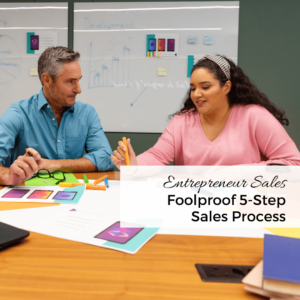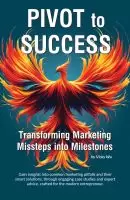- +1 512-591-8295
- [email protected]
- Mon - Fri: 9:00 - 16:00

As a B2B entrepreneur, few things are as crucial to your success as mastering the art of sales. After all, without a steady flow of new customers, your business simply won’t survive – let alone thrive. This is very different from B2C sales – and which is what you will find a LOT of the marketing advice is designed for. It just won’t work the same when you’re selling to other professionals.
The sales process can often feel like a daunting minefield, especially for those who didn’t come from a traditional sales background. Between handling objections, crafting compelling value propositions, and mustering the confidence to ask for the sale, it’s no wonder so many entrepreneurs struggle to convert leads into loyal, paying clients.
But here’s the good news: by implementing a structured, repeatable sales process, you can cut through the uncertainty and start seeing immediate, tangible results. And that’s exactly what I’m going to share with you today.
In this foolproof 5-step sales playbook, I’ll guide you through the essential elements of an effective sales strategy – one that sidesteps high-pressure tactics (fake deadlines? scare tactics? false FOMO? Buyers can spot them miles away) in favor of an authentic, customer-centric approach.
Whether you’re a seasoned salesperson or just starting out, these strategies will transform the way you engage and convert your ideal clients.
So, if you’re ready to take your entrepreneurial sales game to the next level, let’s continue … because sales is a function of marketing.
The first – and perhaps most crucial – step in any successful sales process is understanding the objections and hesitations your potential customers are likely to have. After all, these aren’t roadblocks, but rather opportunities to demonstrate your value and build trust.
Start by conducting thorough research to uncover the top concerns of your target audience. What are the common pain points, challenges, or uncertainties they grapple with when considering a solution like yours? Get inside their heads, and anticipate the questions or doubts they might raise during the sales conversation.
Once you’ve identified these key objections, craft thoughtful, empathetic responses that address them head-on. This isn’t about waiting for them to ask or object – it’s about addressing the likely objections directly in your marketing or sales messages. Avoid dismissing or downplaying their concerns; instead, acknowledge them and demonstrate how your offering can alleviate those specific pain points. This shows that you truly understand your customers’ needs and positions you as a trusted advisor, not just a salesperson.
Remember, objections are a natural part of the sales process. Approach them with an open mind, and use them as a chance to strengthen your connection with the prospect.
With your objection-handling foundation in place, it’s time to focus on the heart of your sales pitch: your unique value proposition. This is where you clearly and concisely communicate the key benefits your offering provides, as well as what sets you apart from the competition.
Start by identifying the specific features, capabilities, and most importantly the outcomes that matter most to your target customers. What problems do you solve? What value do you deliver? Distill these differentiators into a succinct, persuasive statement that highlights the unique ways you can improve your prospect’s business or life.
Avoid getting bogged down in technical jargon or unnecessary details. Instead, keep your value proposition laser-focused on the bottom-line impact you can have. Remember, B2B buyers are looking for solutions that will make their jobs easier, save them money, or drive tangible results.
By crafting a compelling, customer-centric value proposition, you’ll be able to grab your prospect’s attention and clearly articulate why they should choose you over the alternatives.
One of the most powerful tools in a B2B salesperson’s arsenal is the product demonstration (when you have a product that you can demonstrate). When executed effectively, a live, interactive demo can educate and engage your prospects, bringing your value proposition to life in a tangible way.
Start by planning out a structured demo that highlights the core functionality and key benefits of your offering. Focus on showcasing how it solves your customer’s specific pain points, rather than just listing features. Incorporate visual aids, interactive elements, and even real-time data to make the experience as immersive and personalized as possible.
If you don’t have a physical product, that’s okay – you can run webinars or other ways to creatively showcase the benefits of your services.
Throughout the demo, pay close attention to your prospect’s reactions, questions, and body language. Use this feedback to adapt your presentation on the fly, zeroing in on the areas that seem to resonate the most. The goal is to create a dynamic, two-way dialogue, not a one-sided lecture.
Remember, product demos aren’t just about features and functionality – they’re about forging an emotional connection and building trust. By delivering a truly impactful, customer-centric demo, you’ll position yourself as a knowledgeable, helpful partner, not just another salesperson.
Step 4: Ask for the Sale (Confidently, Not Forcefully)
Perhaps the most challenging – and often overlooked – part of the sales process is directly asking for the sale. Many entrepreneurs struggle with this step, fearing that it will come across as pushy or high-pressure. But the reality is, unless you proactively ask for the commitment, you’re leaving the outcome up to chance.
The key is to approach this step with confidence and genuine enthusiasm, not force. Avoid ultimatums or manipulative tactics; instead, clearly reiterate the value you can provide and invite the prospect to take the next logical step. This could be anything from scheduling a follow-up call to signing a contract on the spot.
Keep in mind, those high-pressure sales tactics that are often touted as the way you need to go, have to be done very carefully. Today’s consumer are savvy, and they can spot what feels like a high-pressure sales tactics from far away (you need to decide by the time we get off this call, or by the end of the day because I’m “closing” and it won’t reopen for 6 months) and they often fall flat against professionals who know that fake FOMO is … fake. Worse if you try to shame you for not being interested in their offer (“what, you can’t just put it on your credit card? No Karen, I can but I won’t, because I have different priorities than you, and giving you all of my money isn’t one.”)
If the prospect expresses hesitation or raises additional objections, don’t panic. Respond with empathy and flexibility, addressing their concerns without resorting to hard sells. The goal is to guide them towards a decision, not strongarm them into one.
Remember, a “no” isn’t always a permanent rejection – it may just mean “not right now.” By asking for the sale with professionalism and poise, you’re demonstrating your belief in your offering and your respect for the customer’s decision-making process.
As you start to refine and implement your sales playbook, it’s essential that you systematically document your approach. This not only helps you stay organized and consistent, but it also lays the groundwork for scaling your sales efforts as your business grows.
Begin by creating a centralized sales process playbook or integrating your sales activities into a CRM system. Record detailed notes on your successful strategies, common objections and responses, demo structures, and pipeline management best practices. This creates an invaluable resource that can be easily referenced and shared with new team members.
Documenting your sales process also allows you to continuously analyze and optimize your approach. Regularly review your win/loss ratios, conversion rates, and other key metrics to identify opportunities for improvement. With this data-driven feedback loop in place, you can make informed decisions about which tactics to double down on and which to revisit.
Remember, your sales process is never truly “finished” – it’s an ongoing evolution. By keeping detailed records and continuously refining your approach, you’ll position your business for sustainable, scalable growth.
Finally, it’s crucial to recognize that the sales process doesn’t end with the initial close. In the world of B2B entrepreneurship, the sales cycle is often much longer and more complex than a traditional consumer transaction. That’s why ongoing follow-up and relationship nurturing are essential components of your sales playbook.
Implement a strategic follow-up plan that keeps you top-of-mind with your new customers. This might include regular check-ins, providing educational resources, or sharing relevant industry updates. The goal is to position yourself as a trusted advisor, not just a vendor.
Additionally, don’t be afraid to lean on your existing customer base for new business opportunities. Satisfied clients can be a goldmine for referrals, testimonials, and even cross-selling or upselling. Nurture these relationships, and you’ll unlock a steady stream of repeat revenue and endorsements.
Remember, sales is about more than just the transaction – it’s about building genuine, long-lasting connections. By following up and nurturing your customers, you’ll not only retain their business but also strengthen your reputation as a reliable, customer-centric partner.
There’s no doubt about it – sales can be a daunting task, especially for entrepreneurs who didn’t start out in a traditional sales role. But by implementing this foolproof 5-step process, you’ll be well on your way to transforming the way you engage and convert your ideal clients.
From identifying and addressing key objections to crafting a compelling value proposition and mastering impactful product demos, each of these strategies is designed to help you build trust, deliver value, and guide your prospects towards a successful sale. And by documenting your approach and nurturing your customer relationships, you’ll ensure that this sales playbook scales seamlessly as your business grows.
So what are you waiting for? Start putting these tactics into practice today, and get ready to watch your sales numbers skyrocket. And if you need any additional support or guidance along the way, be sure to explore the resources and services available right here on our website. We’re here to help you increase your profit!
Get the marketing advice I share with my entrepreneur friends ...
... right in your inbox

Get solid marketing strategies, designed for entrepreneurs on the track to 7-figures and beyond, right in your inbox.

This website uses cookies to ensure you get the best experience on our website. By continuing to use the website, you agree to our use of cookies. We do not share or sell your information. More info
